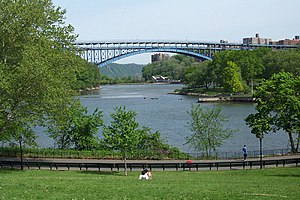Upper Manhattan


Upper Manhattan (or just Uptown ) is the name for the northern part of the New York borough of Manhattan . Uptown borders Midtown Manhattan in the south , which in turn is north of Downtown Manhattan .
location
The southern limit of Upper Manhattan is not officially established. Hence, opinions differ on where Upper Manhattan begins: They range from 59th Street to 155th Street as the southern border. Usually 96th Street is given as the southern border , which is also the southern border of the Manhattan Valley district in the west and Spanish Harlem in the east.
Upper Manhattan is also part of a larger region that New Yorkers call "Uptown". This starts north of 59th Street. Although the Bronx is not located in Manhattan, it is often referred to colloquially as "Uptown" - especially in connection with " Hip-Hop " or "Inner City" culture.
Neighborhood in Upper Manhattan
The following neighborhoods in New York City are the above. By definition in Upper Manhattan:
- Marble Hill
- Inwood
- Washington Heights (including Fort George , Sherman Creek, and Hudson Heights )
- Harlem (including Sugar Hill and Hamilton Heights )
- Parts of the Upper West Side ( Morningside Heights , Manhattan Valley )
history
In the late 19th century, the city expanded through the IRT Ninth Avenue Line (IRT = Interborough Rapid Transit Company , today: New York City Subway ) and other subway lines into the previously village-like Upper Manhattan, resulting in an urbanization of this area led.
In the 20th century, the neighborhoods developed very differently. While Harlem was now impoverished, wealthy New Yorkers settled south on the Upper East Side. The one in the Upper West Side also eventually developed into a wealthy area.
However, until the late 20th century, this area was generally less gentrified than other parts of New York. An exception is the Upper West Side , whose residents are generally more affluent than their neighbors in the north (e.g. Manhattanville , Morningside Heights, Inwood and others). Since gentrification has not yet been completed in some districts of Upper Manhattan, Upper Manhattan is still associated with crime , graffiti, etc. - sometimes wrongly. Gentrification is proceeding here at a different pace than has been experienced in SoHo , the East Village, etc., as the population and social structure is different in north Manhattan .
The Upper East Side is only counted as Upper Manhattan if its beginning is defined as 59th Street, because Spanish Harlem begins at 96th Street (the usual southern border). The Upper East Side is considered one of the most elegant addresses in New York, where almost exclusively very wealthy New Yorkers live. It differs significantly from its northern neighbor, Spanish Harlem. Many diplomatic missions are located in stately homes on the Upper East Side.
tourism
Upper Manhattan is not yet a particularly touristy area of New York, although there are some tourist attractions here - such as The Cloisters . So it is usually left out on city maps for tourists as well as the other boroughs of New York: Bronx , Brooklyn , Queens and Staten Island . Even New Yorkers have the impression that Upper Manhattan is just as much a different borough as Brooklyn, for example. The reasons for this are not least the distance to Midtown Manhattan and the comparatively lower rents, so that New Yorkers no longer count this northern part of Manhattan in what they call “The City”.
See also
Web links
- Brief description of the neighborhoods of Upper Manhattan on iguide
- Brief description of the various sections of Manhattan on citizendium.org (English)
- Map of New York City for bicycle routes (PDF; 2.0 MB)
- Walking and Jogging Routes in Upper Manhattan

